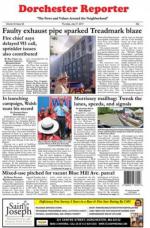June 20, 2018
As parishioners and members of the St. Ann and St. Brendan community began strategizing on how to save their parish, which is in dire financial straits that could lead to dramatic cuts or closures, they decried the lack of specific information from the archdiocese on the state of the individual churches at a public meeting Tuesday night.
Dave Anderson, president of the Cedar Grove Civic Association, led a meeting of around 300 people at Florian Hall. The dynamics of the city are changing, he noted, with younger and less devout generations moving into the neighborhoods.
“The parishioners of St. Brendan’s and St. Ann’s cannot be held accountable for the demands of the society in which we have to live,” he said. “Rather we have held strong to our faith by opting for Catholic schools. It cannot be argued the attendance is dwindling, and I offer no excuse for this. What I offer is an explanation. Society has shifted. Please do not punish faithful residents because their friends and neighbors don’t find the time for Mass. This will only pit neighbor against neighbor in a divisive, unchristian narrative that will serve no one.”
Attendees said they were struggling to process an announcement from the parish priests, who in a letter on May 25 announced that parish leadership must craft a “set of proposals” by mid-August that would then be submitted as recommendations to the archdiocese of Boston by mid-September.
Anderson said they need “tangible guidance and practical assurance” from the archdiocese, which did not send representatives to the meeting. Two members of the parish council, tasked with creating this plan, spoke. Bill Sansone of the St. Brendan’s parish council, said they are “trying to save the entities as we are.”
The council has a meeting on Monday, June 25, he said, but “nothing has been proposed, decided, or moved forward as of this moment.”
Along with about $2 million in deferent maintenance across the two parishes, some $200,000 is being borrowed to cover operations through the end of the year.
To save the two churches, the priests said, weekly Mass attendance at each will need to more than double, to 750 parishioners. Weekly offertories will need to rise by $5,000 in each church, and the $850,000 in debt incurred by both will need to be paid off.
Some who offered public comments wondered if the appropriate strategy would be dealing with the parishes as separate entities, and worried that parochial loyalties would win out.
“I think the people who left St. Brendan’s are going to want to donate to St. Brendan’s,” one woman said. “They have very different problems: one has more capital, the other has operating problems.”
Anderson noted that “the archdiocese doesn’t see us as separate.” A lesson learned from other parish closures, he said, is that “we can succeed together or die alone.”
According to the letter from the priests who now lead the collaborative parish, a mounting deficit between income and operating expenses is more than $40,000 for St. Ann and $26,000 at St. Brendan.
With collections income amounting to a weekly sum of roughly $3,000, “the cash flow is impossible to meet,” they wrote. “Despite being as generous as they can, those who attend can’t support all the expenses of a parish. Hard decisions are necessary.”
Much of the conversation at the meeting revolved around the specific areas in which finances were strained.
“I think that there seems to be confusion on the financial dilemmas we’re facing, and it troubles me,” said Frank Doyle, who was brought up in St. Ann’s parish and lived for the last 30 years in St. Brendan’s parish area. “We both want to survive, but we have to figure out how to do it.”
Those gathered voted to draft and send a letter to the archdiocese requesting a full audit of expenses, so that they might offer a workable plan. Attendees signed up for committees to focus on bringing in new parishioners, write grants, fundraise, engage in alumni outreach, and assess the facilities.
Frustration in the room was palpable regarding the vagueness of the church’s directive. Some were inclined to offer the archdiocese the benefit of the doubt, but others felt the quick process was effectively undermining their ability to help.
Maura Doyle said the sense is “it’s on your lap and if you don’t come up with an answer, and if we have to close it’s not our fault. It’s your fault. There’s not enough information to come up with a feasible, workable, and hopefully successful solution. who does that?”
The group has secured Florian Hall again for a meeting on July 17. A representative from Mayor Martin Walsh’s Office of Neighborhood Services was in the room, and earlier in the day Walsh told the Reporter that he, too, was waiting on more information.
“I don’t know enough about it yet,” he said. “I mean I know the St. Brendan’s and St Ann’s community are very engaged in the process. They’re both valued assets in the city of Boston…I just, as long as there’s an open process, transparent process, whatever’s gonna happen is gonna happen. I mean, I think it’s difficult. It’s going to be difficult for the archdiocese to keep all these properties.”
He recalled the closure over time of several Dorchester churches, parochial schools, convents, and rectories, and noted that others still are struggling. “I think at some point a real serious conversation has to happen,” he said. “I think that’s happening now in St. Ann’s/St. Brendan’s.”
Jennifer Smith can be reached at jennifer.smith@dotnews.com or @JennDotSmith.



